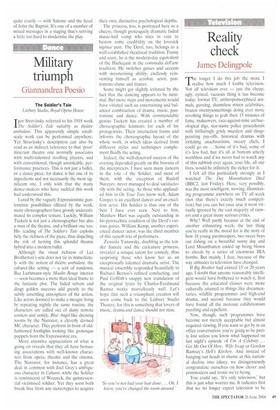Military triumph
Giannandrea Poesio
The Soldier's Tale Linbuty Studio, Royal Opera House
Igor Stravinsky referred to his 1918 work The Soldier's Tale suitably as tha Ire ambulant. This apparently simple smallscale work can be performed anywhere. Yet Stravinsky's description can also be read as an indirect reference to that 'poor' itinerant theatre one normally associates with multi-talented strolling players, and with conventional, though unsinkable, performance practices. This is not just a ballet, or a dance piece, for dance is but one of its ingredients and not necessarily the most significant one. I only wish that the many dance-makers who have tackled this work had understood this.
Lured by the vaguely Expressionistic pantomimic possibilities offered by the work, many choreographers have grossly underestimated its complex texture. Luckily, William Tuckett is not just a choreographer but also a man of the theatre, and a brilliant one too. His reading of The Soldier's Tale exploits fully the richness of the piece, thus dispelling the risk of turning this splendid theatre hybrid into a modern ballet.
Although the visual richness of Lez Brotherton's sets does not tie in immediately with the notion of theatre ambulant, the cabaret-like setting — a sort of rundown, Baz Lurhmann-style Moulin Rouge interior soon becomes a more than ideal frame to the fantastic plot. The faded velvets and dingy golden stuccoes add greatly to the subtly unsettling atmosphere of the action. Like actors doomed to make a meagre living by repeating nightly the same routine, the characters are called out of dusty remote corners and untidy, Blue Angel-like dressing rooms by the Narrator, a cleverly devised MC character. They perform in front of oldfashioned footlights looking like grotesque puppets from the Expressionist era.
More attentive appreciation of what is going on reveals that they all have bemusing associations with well-known characters from opera, theatre and the cinema. The Narrator, for instance, has a great deal in common with Joel Grey's ambiguous character in Cabaret, while the Soldier is reminiscent of Wozzeck, the quintessential victimised soldier. Yet they soon both break free from any stereotypes to acquire their own, distinctive psychological depths.
The princess, too, is portrayed here as a cheesy, though grotesquely dramatic faded music-hall vamp who tries in vain to bestow some credibility on the lovesick ingenue part. The Devil, too, belongs to a well-established theatrical tradition. Funny and scary, he is the modern-day equivalent of the Harlequin in the commedia dell'arte tradition. He switches guises and accents with mesmerising ability, endlessly reinventing himself as acrobat, actor, pantomime-dame and dancer.
Some might get slightly irritated by the fact that the dancing appears to be minimal. But more steps and movements would have vitiated such an entertaining and balanced combination of drama, music, pantomime and dance. With commendable genius Tuckett has created a number of choreographic leitmotiv for each of his protagonists. Their interaction forms and informs the choreographic layout of the whole work, in which ideas derived from different styles and techniques complement fluidly the acting.
Indeed, the well-deserved success of the evening depended greatly on the bravura of the interpreters. I have seen many dancers in the role of the Soldier, and most of them, with the exception of Rudolf Nureyev, never managed to deal satisfactorily with the acting. As those who applauded him in On Your Toes know well, Adam Cooper is an excellent dancer and an excellent actor. His Soldier is thus one of the best I have ever seen. Next to him, Matthew Hart was equally outstanding in his pyrotechnic rendition of the Devil's various guises. William Kemp, another experienced dancer/actor, was the third member of this superb trio of performers.
Zenaida Yanowsky, doubling as the tender fiancee and the caricature princess, revealed a unique talent for comedy, thus surprising those who know her as an exceptionally talented dramatic artist. The musical ensemble responded beautifully to Richard Bernas's refined conducting, and Paul Griffith's snappy new translation of the original lyrics by Charles-Ferdinand Ramuz works marvellously well. Let's hope that such a triumphant creation will soon come back to the Linbury Studio Theatre, for this is something that lovers of music, drama and dance should not miss.


































































 Previous page
Previous page